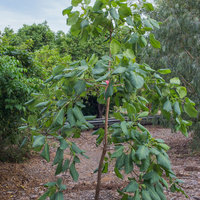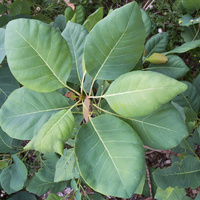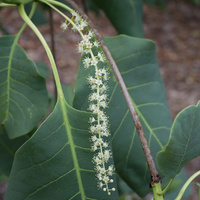Common name: Kakadu Plum
Other common names: Billy Goat Plum, Bush Plum, Gubinge, Salty Plum
Description
Kakadu Plum is an Australian native tree producing fruit with the highest known vitamin C content of any fruit, reportedly more than sixty times that of oranges.
The tree's natural range is limited to the tropical north of the Australian continent, where it occurs in open woodlands extending along the coastal plain from Broome, east through Kununurra, Darwin and Katherine to the Cape York Peninsula.
It is a small to medium-sized tree, reaching heights of up to 12 m (40 ft), though is more commonly 5 to 10 m (16 to 32 ft) tall with a single, slender and straight trunk, occasionally low-branching on poor sites, supporting a wide-spreading crown. The bark is light grey, mottled and slightly rough.
Leaves large, oval, up to 25 cm (10 in) long, bronze-red when they emerge, maturing to green with yellow ribs, then in the dry season turn yellow and fall to the ground to conserve water. They are arranged spirally along the stems, toward the ends of the branches.
Flowers creamy-white, small and insignificant, borne on long flower spikes at the tips of the branches. They come into bloom at the transition from the dry to the rainy season, which coincides with spring to summer in its native range.
The fertilised flowers are followed by nippled oval fruit, 2 to 3 cm (0.8 to 1.2 in) long, green when young, becoming yellow-green, less commonly purple, when ripe, with fleshy pulp surrounding a large seed.
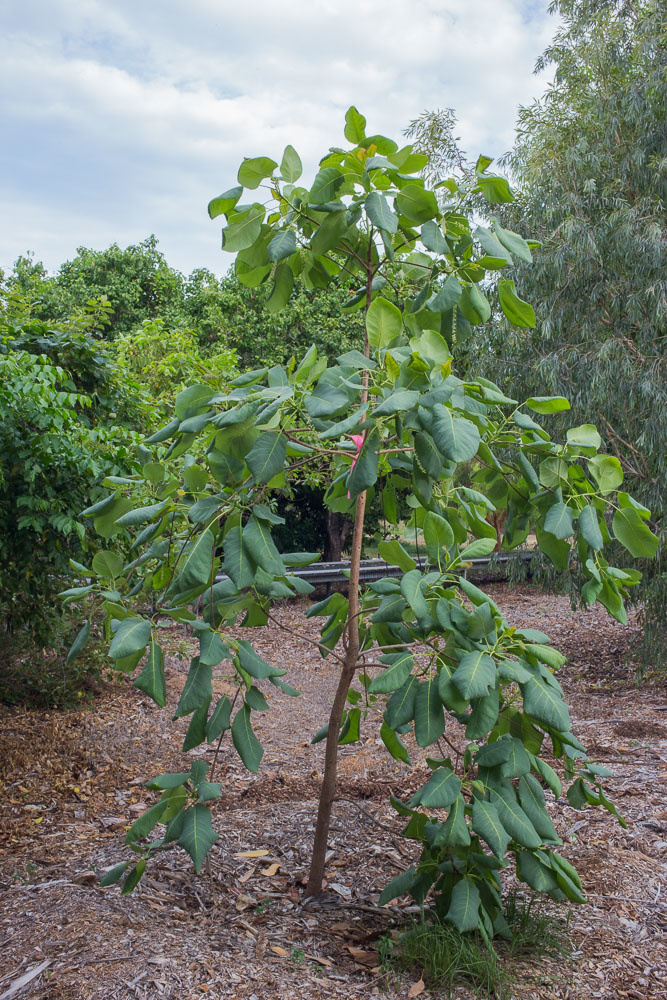
Young tree, Darwin, Australia
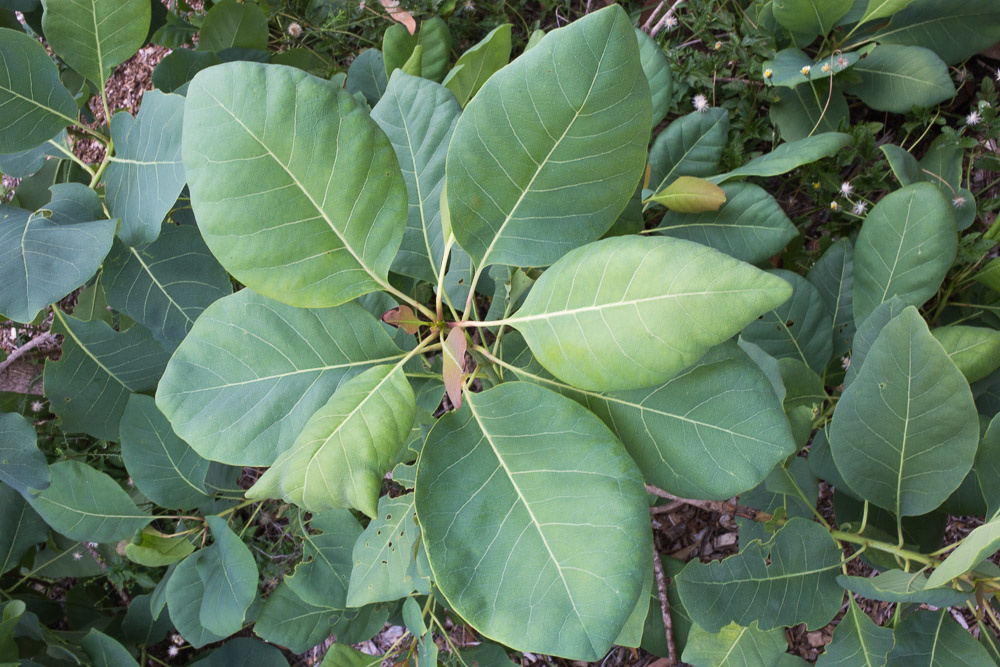
Leaves
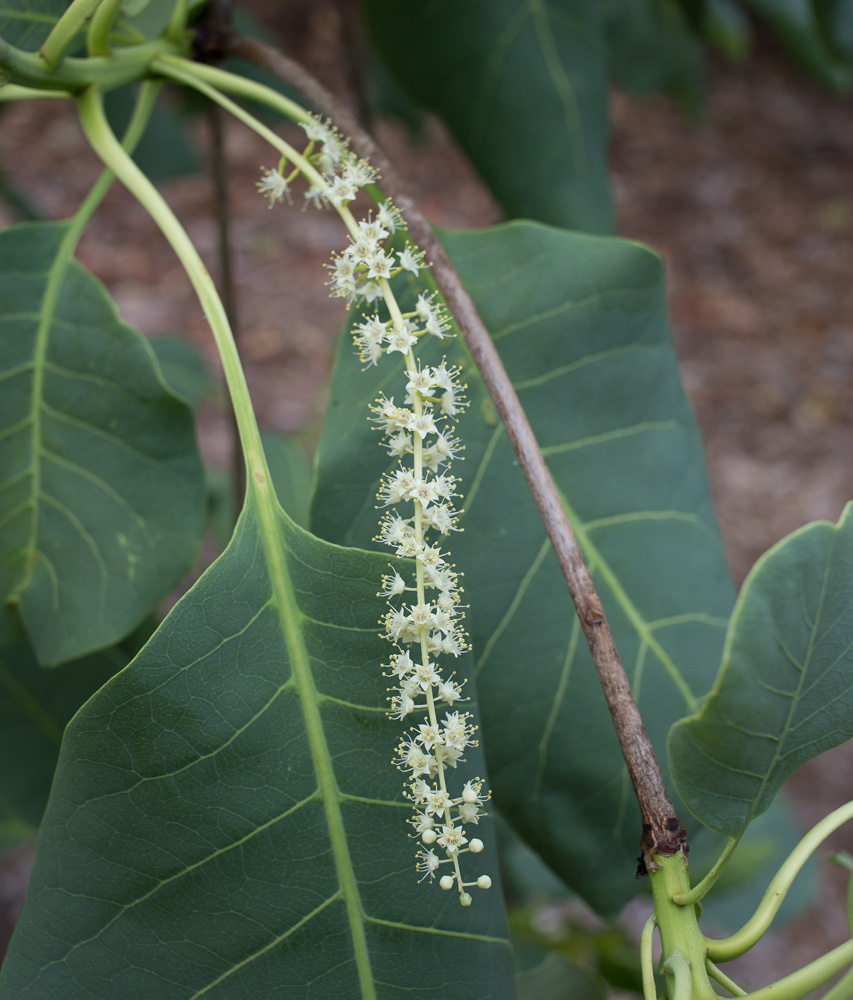
Flowers
Use
The ripe fruit are a popular wild-harvested snack food in its native range. They are eaten fresh out-of-hand, by biting into the pulp, which though scant, is juicy with a fibrous texture and pleasingly sour, somewhat astringent flavour, described as reminding of gooseberries. Due to its sourness, it has limited value as a commercial fresh fruit.
The pulp has long been used to make jam but more recently, with the discovery of its high vitamin C and antioxidant content, demand has increased for its use in pharmaceutical, health-food and cosmetic products.
Commercial operations have recently been set-up in remote communities, in northern Australia, for wild-harvested fruit to be frozen (within twenty-four hours), then transported to processing facilities where the pulp is removed, pureed and freeze-dried into a powder. The powder has found its way into a range of products as a health and beauty promoting ingredient, including health foods, dietary supplements and skincare cosmetics.
Researchers have also found the freeze-dried pulp to possess strong antimicrobial properties and it has been successfully tested as a natural preservative by the seafood industry in Australia, showing good results in extending the shelf-life and maintaining the appearance of fresh shellfish, particularly prawns and shrimp.
Climate
Grows naturally in sub-humid to moderately humid tropical coastal climates, generally in areas with annual lows of 20 to 25°C, annual highs of 30 to 35°C, annual rainfall of 600 to 2000 mm and a dry season of 4 to 8 months.
Growing
Although most of the fruit comes from wild-growing trees, there are reports of trees being raised from seed for enrichment and orchard plantings. The seed are extracted from fruit that has ripened and fallen to the ground, then are sown in containers with a free-draining potting mix. Seedling trees start to flower and bear fruit when about five to six years old.
It is adapted to a wide variety of well-drained clay, loam and sand soils of a moderately acid to slightly alkaline nature, generally with a pH of 5.0 to 7.5, and performs best on sites with full to partial sun exposure. It has good tolerance to drought and seasonal flooding but poor tolerance to slow-draining or waterlogged soils.
Problem features
There does not appear to be any record of it anywhere as a weed or invasive species and the likelihood of it becoming a problem weed species is low, due to the relatively large size of the fruit and seed, which makes them not easily dispersed.
Where it grows
References
Books
-
Barwick, M., et al. 2004, Tropical & subtropical trees : a worldwide encyclopaedic guide, Thames and Hudson, London
-
Norrington, L. & Campbell, C. 2001, Tropical food gardens : a guide to growing fruit, herbs and vegetables in tropical and sub-tropical climates, Bloomings Books, Hawthorn, Victoria
-
Sultanbawa, Y. & Sultanbawa, F. 2016, Australian native plants : cultivation and uses in alternative medicine and the food industry, CRC Press, Boca Raton, Florida
